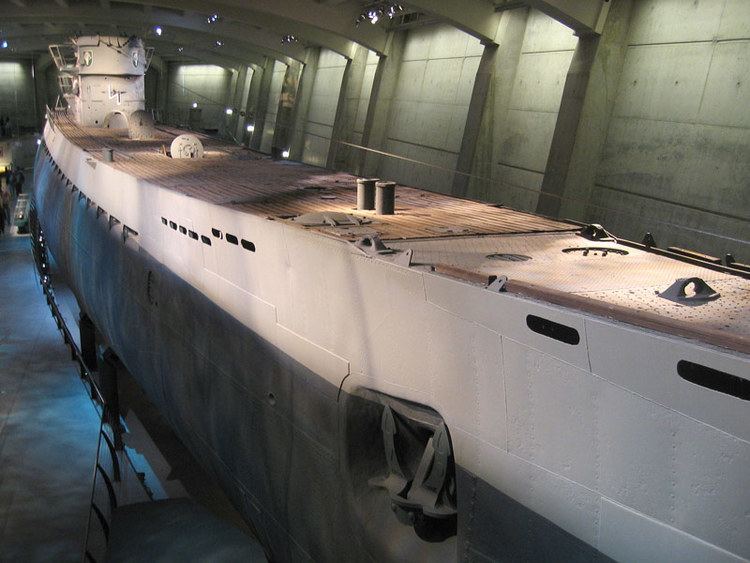Name U-163 Yard number 702 Commissioned 21 October 1941 Launched 1 May 1941 Draft 4.7 m | Ordered 25 December 1939 Laid down 8 May 1940 Construction started 8 May 1940 Length 77 m Beam 6.76 m | |
 | ||
Fate Sunk on 12/13 March 1943 by a Canadian warship Builder Deutsche Schiff- und Maschinenbau Part of Kriegsmarine, 4th U-boat Flotilla, 2nd U-boat Flotilla | ||
German submarine U-163 was a Type IXC U-boat of Nazi Germany's Kriegsmarine built for service during World War II. The keel for this boat was laid down on 8 May 1940 at the DeSchiMAG, Bremen yard as yard number 700. She was launched on 1 May 1941 and commissioned on 21 November under the command of Korvettenkapitän Kurt-Eduard Engelmann.
Contents
The U-boat's service began with training as part of the 4th U-boat Flotilla. She then moved to the 10th flotilla on 1 August 1942 for operations. She sank three ships, totalling 15,011 tons and one warship was declared a total loss (1,130 tons).
She was sunk by a Canadian corvette in March 1943.
Design
German Type IXC submarines were slightly larger than the original Type IXBs. U-163 had a displacement of 1,120 tonnes (1,100 long tons) when at the surface and 1,232 tonnes (1,213 long tons) while submerged. The U-boat had a total length of 76.76 m (251 ft 10 in), a pressure hull length of 58.75 m (192 ft 9 in), a beam of 6.76 m (22 ft 2 in), a height of 9.60 m (31 ft 6 in), and a draught of 4.70 m (15 ft 5 in). The submarine was powered by two MAN M 9 V 40/46 supercharged four-stroke, nine-cylinder diesel engines producing a total of 4,400 metric horsepower (3,240 kW; 4,340 shp) for use while surfaced, two Siemens-Schuckert 2 GU 345/34 double-acting electric motors producing a total of 1,000 metric horsepower (740 kW; 990 shp) for use while submerged. She had two shafts and two 1.92 m (6 ft) propellers. The boat was capable of operating at depths of up to 230 metres (750 ft).
The submarine had a maximum surface speed of 18.3 knots (33.9 km/h; 21.1 mph) and a maximum submerged speed of 7.3 knots (13.5 km/h; 8.4 mph). When submerged, the boat could operate for 63 nautical miles (117 km; 72 mi) at 4 knots (7.4 km/h; 4.6 mph); when surfaced, she could travel 13,450 nautical miles (24,910 km; 15,480 mi) at 10 knots (19 km/h; 12 mph). U-163 was fitted with six 53.3 cm (21 in) torpedo tubes (four fitted at the bow and two at the stern), 22 torpedoes, one 10.5 cm (4.13 in) SK C/32 naval gun, 180 rounds, and a 3.7 cm (1.5 in) as well as a 2 cm (0.79 in) anti-aircraft gun. The boat had a complement of forty-eight.
1st patrol
The submarine's first patrol took her from Kiel on 21 July 1942, across the North Sea and through the 'gap' between Iceland and the Faroe Islands. She arrived at Lorient, in occupied France, on 16 January. She would be based at this Atlantic port for the rest of her career. She had crossed the Atlantic Ocean and sailed to the southern Cuban coast.
2nd patrol
Her second foray took her to the area north of South America. Here she sank La Cordillera on 5 November 1942 85 nmi (157 km; 98 mi) east of Barbados. She also damaged an American gunboat, USS Erie on 12 November and sank Empire Starling northeast of Barbados on the 21st. Her final victim on this patrol was Apóide which went down a day later. She returned to Lorient on 6 January 1943.
3rd patrol and Loss
The U-boat departed Lorient for the last time on 10 March 1943. On the 13 March 1943, she was sunk by depth charges from HMCS Prescott northwest of Cape Finisterre, Spain. 57 men (all hands) died.
